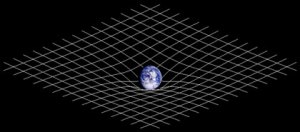Mar 18 2014
If you want to know your body's mass, you hop on a scale and watch the needle swing. But if you want to know the mass of a region out in space, there's no cosmic equivalent -- the best you can do is consult a geometric formula.
 Large objects, like Earth, bend spacetime itself. (Photo: Wikimedia Creative Commons)
Large objects, like Earth, bend spacetime itself. (Photo: Wikimedia Creative Commons)
Three recent mathematical proofs take aim at refining one of the most useful of these formulas: Stephen Hawking's definition of a region's mass in a spacetime. A team of three mathematicians and physicists recently published their work on the pre-print website arXiv.org.
Using general relativity, Albert Einstein's theory of gravity, mathematics can describe behaviors of the physical world, like the motion of the planets around the Sun and the peculiar orbit of Mercury. But determining the precise mass of an object is a hopeless task for a single formula because of the way massive objects curve spacetime itself.
"The problem of defining the mass inside a given region of a spacetime is fundamental to understanding general relativity, which is the current reigning theory of the large-scale structure of the universe," said Hubert Bray, professor of mathematics and physics at Duke University.
Lacking a universal, one-size-fits-all equation, mathematicians and theoretical physicists have crafted dozens of formulas that approximate the mass of a region. "They're all educated guesses, and none are perfect in every way," Bray said. The more accurate the mass function, he added, the more complicated the formula that expresses it.
Australian mathematician Robert Bartnik, for example, defined a formula for the mass of a region that is the "gold standard for what the correct answer really is," Bray said. "But it is also nearly impossible to compute."
The Hawking mass is another option. Renowned physicist Stephen Hawking developed his theory of mass in general relativity, also known as the Hawking energy, in the 1960s. Half a century later, it remains a favored definition of mass due to its simplicity.
"The Hawking mass is a nice, simple formula," Bray said, but it too has limits. While simple to compute, it rarely has the properties scientists want. "However, we were able to show that the Hawking mass does work very well for regions bounded by special surfaces called time-flat surfaces." (Time flat refers to the surface staying in the present, as opposed to part of the surface being in the future and part being in the past.)
Bray likens outer space to a king-sized bed, with a quilt standing in for the fabric of spacetime. If you place a large object like a bowling ball on the bed, it's going to create a dimple in the quilt. Smaller objects, like golf balls, create smaller dimples. And if you roll a golf ball across the quilt, rather than taking a straight course, it will curve around the dimple of the bowling ball.
This effect -- the curvature of spacetime -- is what makes calculating the mass of a region in deep space so tricky.
It makes intuitive sense that a region of a spacetime with positive matter density everywhere (from stars, planets, gas and dust) should itself have positive mass, Bray said. It also seems intuitive that subsequently larger regions should have subsequently larger masses. But intuition is not enough -- mathematicians must prove that a formula for the mass of a region, like the Hawking mass, actually has this property in some cases.
"And what's remarkable is that such a compact formula as the Hawking mass does have this increasing property," Bray said, "as long as the regions are bounded by time-flat surfaces."
Bray and his coauthors built on this property, writing geometric proofs showing that according to the Hawking mass, a region's mass will always increase as its size increases. The Hawking mass still isn't a perfect functional, Bray said, but it is remarkably useful for this natural class of spacetime surfaces.
The geometry used in these proofs has come a long way since the days of Greek mathematician Pythagoras, Bray said. "If Pythagoras were alive today, he wouldn't be studying triangles and squares, he'd be studying spacetimes. We have triangles and squares pretty well figured out, but many of the most interesting questions about the geometry of spacetimes are still wide open. We have a lot of work to do."
Coauthors on this project included Jeffrey Jauregui, who received his PhD from Duke and is now an assistant professor of mathematics at Union College, and Marc Mars, a professor at the University of Salamanca in Spain.
CITATIONS: "Time Flat Surfaces and the Monotonicity of the Spacetime Hawking Mass II," Hubert Bray, Jeffrey Jauregui, Marc Mars. ArXiv.org, Feb. 14, 2014. arXiv:1402.3287.
"Time Flat Surfaces and the Monotonicity of the Spacetime Hawking Mass," Hubert Bray, Jeffrey Jauregui. ArXiv.org, Dec. 13, 2013. arXiv:1310.8638.